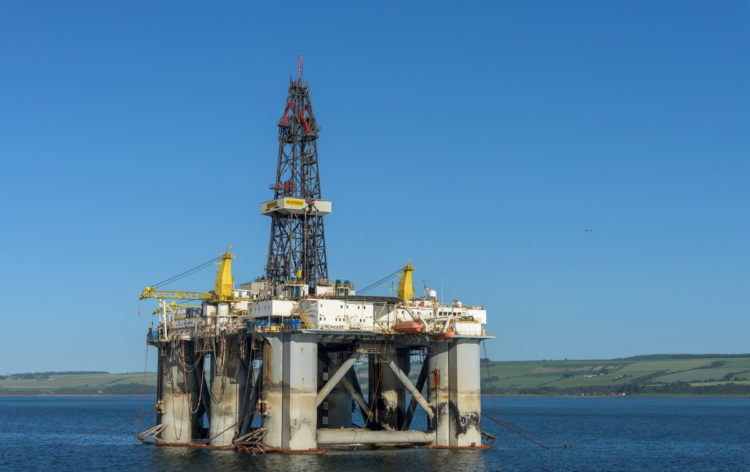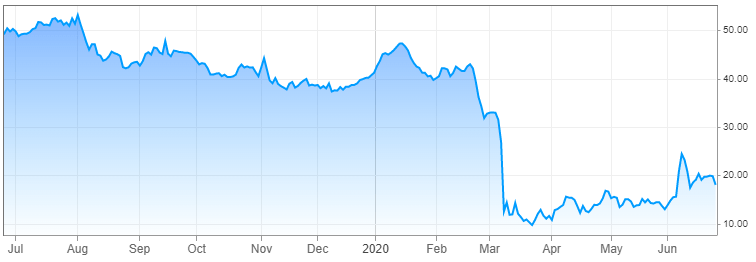What is Reason Behind Recent Decline of Occidental Petroleum Stock?

After a brief recovery during the early June 2020, the shares of Occidental Petroleum Corporation (OXY) have resumed their downtrend. By the end of Tuesday’s trading, the stock closed at $19.79. The next trading session brought more bad news for company shareholders, as OXY fell by more than 9%, dropping all the way down to $18.00. If this downtrend persists for several more days, the stock might return to free-falling mode, just like during the March 2020 stock market crash.
Many investors and stock traders might wonder what is behind this recent dynamic. This might seem illogical since the energy prices have recovered substantially during the last few months. By the end of April 2020, Crude oil was trading near $12. After some steady recovery, the price of this commodity has already reached $37.
Considering the historical developments of oil prices, the $37 level might not be that impressive. Still, it is obvious that the commodity is in an uptrend and recently has made some significant gains. This means that oil companies are well-positioned to benefit from higher revenues and recover from the previous quarter’s losses. In addition to that, some commentators and financial experts are forecasting the oil to return to $50 or even $60 level, before the end of the year. If this materializes, then this can go a long way to aid the oil industry in its recovery.
Financial Problems of Occidental Petroleum Corporation
At this stage, we have an obvious question: If an oil price is on road to recovery, then why does the Occidental Petroleum stock is in a decline? To answer this question, we need to take a look at the company’s financial performance. According to the latest quarterly report, the firm has reported a net loss attributed to common stockholders at $2,232 million. At the same time, the loss per share stood at $2.49. By comparison during the first quarter of 2019, Occidental Petroleum Corporation posted a $631 million in net income, with the EPS standing at $0.84.
This contrast shows the scale of financial challenges faced by the company’s management. The firm has yet to publish its second-quarter earnings. Since it will inevitably include April and May, during which the oil price was very low, it is highly likely that the company will disclose some considerable losses.
There are two additional factors that might have a negative long term impact on the share price. Firstly, back in August 2019, the firm completed a purchase of Anadarko Petroleum Corporation. At the time the deal was considered as a major success by Occidental Petroleum management. The reasoning behind this was that firstly it removed the major competitor of the company from the picture, which always lets other companies increase their market shares. Also, the firm has inherited some high-value assets from Anadarko Petroleum Corporation. This gave the company management some options, they could sell those assets for cash or alternatively, use them to expand the company’s operations.
However, the obvious downside of this deal was the fact that Occidental Petroleum Corporation had to pay $38 billion for this acquisition. This left the company with much less cash to work with at precisely the wrong moment. After the outbreak of COVID-19 pandemic, when all major companies are trying to mobilize as much of cash reserves as possible. Yet the firm is in a difficult position, since it recently spent much of its resources, taking over one of its competitors.
Obviously, the company management is taking some meaningful measures to address this vulnerability of the business. As the recent earnings report mentioned, the firm plans to reduce its capital expenditures by 50%, saving around $2.5 billion in the process. The company also aims to cut operating and overhead costs by $1.1 billion.
It is obvious that taking those measures are essential for the immediate survival of the business. However, this does mean that during the following years, the company might be at a disadvantage compared to its competitors, in terms of its productivity and the size of the workforce.
Finally, shareholders also paid a heavy price for the recent cuts. As late as in 2019, the firm’s quarterly dividends amounted to 79 cents per share. However, due to those cuts mentioned above, the quarterly payout to shareholders was cut to just 1 cent per share. It goes without saying that this delivered a serious blow to those pension funds and individual investors, who were invested in the stock heavily, in order to receive some steady income.
Recent Stock Price Performance of Occidental Petroleum Corporation

source: cnbc.com
As we can see from the above diagram the OXY was already in the long term decline well before the outbreak of COVID-19 pandemic and the decline of the oil prices. The stock fell from $50 in August 2019 to $40 in February 2020. However, the worst collapse was yet to come. As a result of the March 2020 stock market crash, OXY fell to just $10 before the end of the month.
The stock did try to rally during the following months, at one point even reaching the $24 mark. However, this turned out to be very short-lived, as the decline resumed, with the shares currently trading at $18.
The current prices might seem quite cheap, yet this might not be the best way to purchase OXY stock. The company has recently suffered billions of dollars in losses and its cash reserve may not be enough to tackle challenges of the current economic downturn. Therefore it might be much wiser to wait until it becomes clear whether the firm’s management will be in a position to overcome recent problems and restore the company’s profitability.
In terms of income investing, this stock is far from attractive. It only has a 0.2% yield. In fact, US investors can get higher returns with Certificates of Deposit (CD) or on savings accounts with their invested principal protected from market fluctuations.


























Comments (0 comment(s))